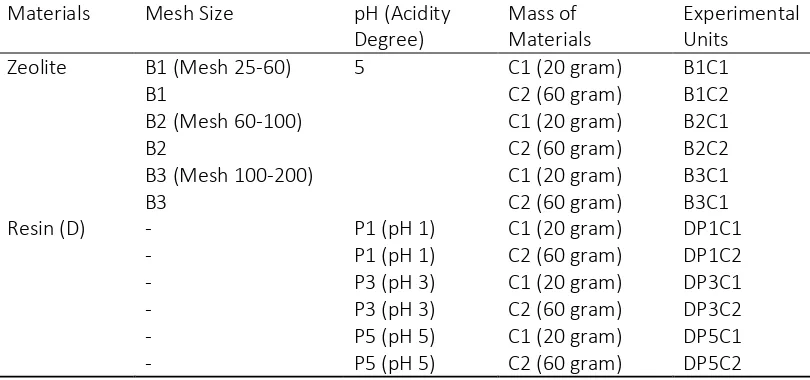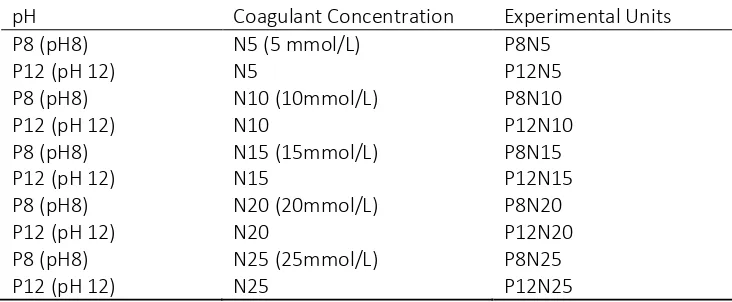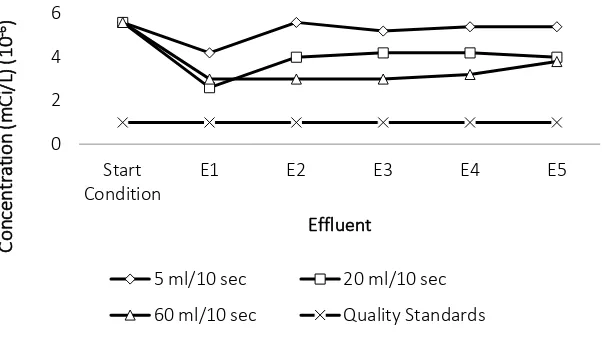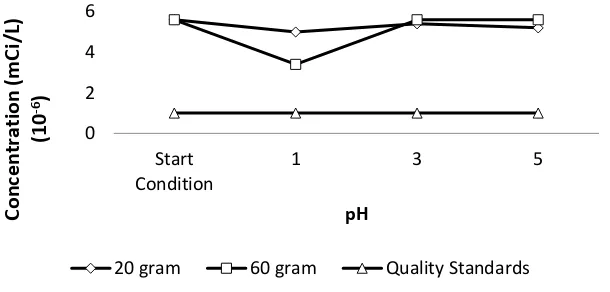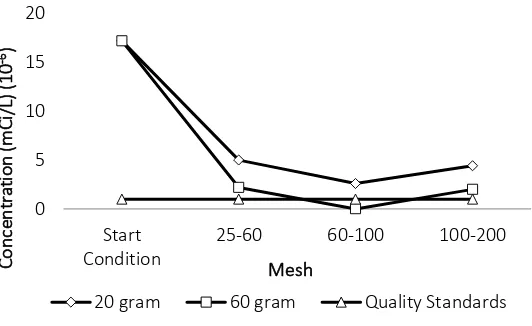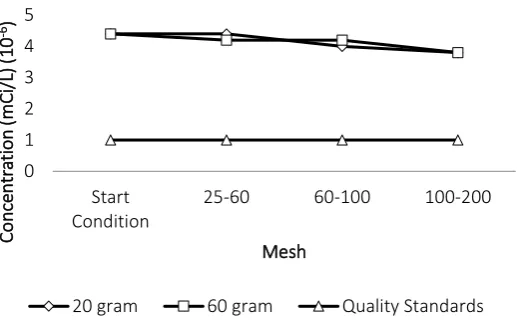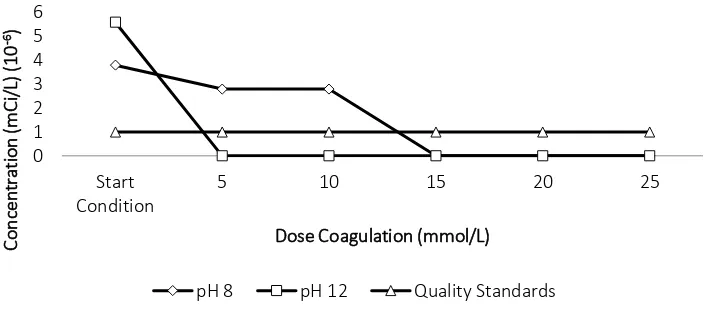Cs-137 AND Co-60 CONCENTRATION REMOVAL ON RADIOACTIVE LIQUID
WASTE BY ION EXCHANGE AND COAGULATION-FLOCCULATION METHOD
Pinky Septria Adella
1, Asih Wijayanti
1, Dwi Indrawati
1, Sugeng Purnomo
21 Environmental Engineering, Faculty of Landscape Architecture and Environmental Engineering,
Universitas Trisakti, Jakarta, 11440, Indonesia
2 Department of Analysis Laboratory and Radioactive Waste Treatment, Radioactive Waste Technology
Center, BATAN, South Tangerang, 15311, Indonesia
*Corresponding author: [email protected]
ABSTRACT
Radioactive liquid waste is a hazardous and toxic waste which comes from nuclear research laboratory. This waste may cause explosion when treated with evaporator. Aim: This research was intended to reduce and determine the best removal method of Cs-137 and Co-60 from radioactive liquid waste. Methodology and Result: Methods used in this research are ion exchange and coagulation-flocculation method. In ion exchange method used two types of reactor that is continuous reactor and batch reactor with variables of debit, material type, mesh size and mass of material, while in coagulation-flocculation method used jar test with ferro sulfate coagulant dose variables. Continuous reactor consisting of separating funnel and chromatography column with a diameter of 4 cm and height 60 cm, whereas in batch reactor used jar test stirrer. The application of radioactive liquid waste treatment is done using selected method, with the start condition for Cs-137 of 3 x 10-5 mCi/L and for Co-60 of 4.8 x 10-6 mCi/L. Application of Ion Exchanger with Continuous Reactor Speed 60 mL/10 sec and Coagulation-Flocculation with dose of 100 mmol/L in pH 8 effluent result the value for Cs-137 and Co-60 that undetected or very little, below 10-6 mCi/L. Conclusion, significance and impact study: The conclusion of this study is suitable with the Government Regulation Number 10 of 1997 about nuclear power, the limit of quality standard for Cs-137 and Co-60 is below 10-6 mCi/L. So the appropriate method to treat of Cs-137 and Co-60 are Ion Exchanger with Continuous Reactor Speed 60 mL/10 sec and Coagulation-Flocculation with dose of 100 mmol/L in pH 8.
1.
INTRODUCTION
Radioactive waste is a waste or material contaminated with radioactive material or exposure to
radionuclide radiation that over the levels or safety limits. Radioactive waste can radiate
radiation, so if it not treated properly, the radionuclides can be released into the environment
and can be dangerous to human health. According to the Government Regulation of the
Republic of Indonesia Number 33 Year 2007 about the Safety of Ionizing Radiation and Security
of Radioactive Waste Source, radiation can adversely affect human health, because radiation
can cause ionization (ionizing effect). The ionization is process of electron separation from
atoms and ion pairs formed, so can cause gene mutations due to errors of cell damage and
disruption of organ function to human body.
In the period of time the amount of radioactive waste from the Center of Radioactive Waste
Technology-BATAN reaches 292 m3, comes from BATAN laboratory and BATAN reactor center.
Radioactive liquid waste management can be done with evaporator and ion exchanger, but
there are some radioactive liquid wastes that cannot be treated with evaporation because of it
explosive characteristic (Center for Radioactive Waste Technology, 2017).
Research about treatment for radioactive liquid waste from BATAN Reactor Center by ion
exchange method has been done since 2014. Processing by coagulation-flocculation method
was done based on Uranium precipitation research using FeCl3 (Kuncoro, 1996). According this,
the research for Cs-137 and Co-60 concentration removal uses the same method but different
coagulant.
The point of the research is to remove the radionuclide parameters from radioactive liquid
waste. Radionuclide parameters present in radioactive liquid wastes is Ru-103, Pb-212, Ta-182,
Pb-214, Bi-214, Cs-137, J-133, Co-60 and K-40. In this study only Cs-137 and Co-60 that will be
consider to be remove from sample. This is because Cs-137 and Co-60 have a long half-life and
enormous energy, while other radionuclide parameters have short half-life and small energy
(Argonne National Laboratory, 2004). The safety limits of radionuclides Cs-137 and Co-60 in
effluent are expected to be met with quality standard of Government Regulation Number 10 of
1997 about nuclear power, which is the maximum concentration of Cs-137 and Co-60 are both
2.
RESEARCH METHODOLOGY
Stages used in this study divided into two stages i.e. stages of selection methods and stages of
the application of radioactive liquid waste treatment. At the selection stage the method is
performed by giving various treatment to each method, such as reactor type, discharge,
material type, mesh size, material mass and coagulant concentration. The reactor used in the
ion exchange method consists of a continuous reactor and a batch reactor. In the continuous
reactor, various discharges is applied, which are small discharge, medium discharge and high
discharge. In the batch reactor is applied various type of material to absorb, which are the resin
and zeolite. Zeolite is used because it is an alternative ion exchange material. Zeolite can only be
used in batch reactor method and cannot be used in the continuous reactor because of the very
fine size of the zeolite mesh that cannot be filtered on the effluent ,so it will flow to outlet and
contaminate effluent.
In the zeolite, there are various kinds in the size of the mesh and the mass of the material,
while the resin are in the material mass difference and the pH (acidity degree). The resin does
not use various in the mesh size because the resin did not have mesh size. Different with in
zeolite, pH variation does not use as treatment variable because zeolite effectively absorbs in
specific pH. According to Lestari (2010), low-silicon zeolite is easily damaged at a pH less than 4
but according to Zamroni (2000), zeolite can absorb radionuclide parameters optimally at pH 5,
so in this experiment batch reactor method with zeolite runs at pH 5. The resin used in the ion
exchange method is a Na-content resin based on a study, since the Na+ absorbs more optimum
radionuclide parameters in radioactive liquid waste than the H+ (Indah, 2017). The using of
zeolites is based on research that zeolites can be used as absorbent materials to reduce harmful
metals in wastewater.
In coagulation-flocculation method, as variable are coagulant concentration and pH
variations. The coagulant used in this study is ferrous sulfate salts with concentration variations
are 5 mmol/L to 25 mmol/L and pH variations are pH 8 and pH 12. Based on reference
coagulation-flocculation treatment method can be used to exclude heavy metals where Co-60 is
consider as heavy metal. Measurement of concentration used Multi Channel Analyzer with one
hour enumeration for every 500 mL sample. The result of this measurement is made in graph
At the stage of application, treatmen method is chosen based on the analysis of the test of
selection method. The selected method is a combination of ion exchange method and
coagulation-flocculation which gives the highest removal concentration of Cs-137 and Co-60. At
this stage, the research was conducted twice (duplo) for each alternative treatment method,
then the result was measured using Multi Channel Analyzer for one hour enumeration for every
500 mL sample.
The experimental design of the ion exchanging method used two types of reactor that is
continueous reactor and batch reactor. In the selection stage, ion exchange run in continuous
reactor with variation of debit of low speed, medium speed and high speed in neutral pH. The
debit is determined with matching the condition of the glass column reactor by rotating the
water valve and the resulting water measures every 10 seconds and then put into a measuring
cup to measure the amount of water held. The result of the preliminary test is obtained that the
smallest debit of this glass column reactor is 5 ml/10 sec and the largest debit is 60 ml/10 sec
(Table 1).
Table 1 Ion exchanger research design in continuous reactor
Debit Experimental unit V1 (5 ml/10 sec) V1
V2 (20 ml/10 sec) V2 V3 (60 ml/10 sec) V3
Table 2 Ion exchanger research design with batch reactor
Ion exchange treatment in batch reactor uses two kind of materials that is zeolite in pH
condition 5 and resin in pH condition 1, 3 and 5 (Table 2). In the treatment with
coagulation-flocculation method using two variables that is pH variable and coagulant concentration
variables (Table 3).
Table 3 Coagulation-Flocculation research design
pH Coagulant Concentration Experimental Units
P8 (pH8) N5 (5 mmol/L) P8N5
P12 (pH 12) N5 P12N5
P8 (pH8) N10 (10mmol/L) P8N10
P12 (pH 12) N10 P12N10
P8 (pH8) N15 (15mmol/L) P8N15
P12 (pH 12) N15 P12N15
P8 (pH8) N20 (20mmol/L) P8N20
P12 (pH 12) N20 P12N20
P8 (pH8) N25 (25mmol/L) P8N25
P12 (pH 12) N25 P12N25
The research design of application of liquid radioactive waste treatment is based on
determination in selected method that is the method with the greatest removal concentration
of Cs-137 and Co-60.
3.
RESULTS AND DISCUSSION
3.1
Result of Radioactive Liquid Waste Treatment with Ion Exchanger Method in
Continuous Reactor
Results of ion exchanger continuous reactor with three debit variations can be seen in Figure 1
and Figure 2. In Figures 1, it can be seen that there is reduction of Cs-137 concentration at the
three debit variations. The optimum reduction is occur at debit of 60 ml/10 sec, where Cs-137
concentration on the effluents is undetectable in the sample until breakthrough capacity. While
Figure 1 Cs-137 concentration after treatment in continuous reactor
Figure 2 Co-60 Concentration after treatment in continuous reactor
Electronegativity is measure of the tendency of an atom to attract electrons into covalent
bonds itself (Widyatmoko, 2009). Based on the periodic table, Cobalt is in class VIIIB and has 2+
ion while Cessium is in class IA and has 1+ ion, so the electronegativity of Cobalt is greater than
Cessium. Based on electronegativity, a cation exchange resin with sodium content is expected
to absorb Co-60 and release the sodium first. However, in this study this cation exchange resin
As seen in the (1) reaction, the resin should release the Sodium into the waste after
absorbing the Co-60. However, since this liquid radioactive waste has treated before by caustic
soda, this waste already contains a lot of Sodium, so the release of Co-60 is not effective
because the sodium in waste pressing the sodium in resin to release from the resin, so the
chemical equilibrium is disrupted. Thus, the cation exchange in this study was disrupted
because the chemical equilibrium shifted to the left. This causes the sodium cation exchange
resin to tend to absorb more Cs-137 than Co-60.
R − Na + Cs+⇔ R − Cs + Na+ (2)
Based on Figure 1 it can be seen that the breakthrough capacity of Cs-137 concentration
absorption at the debit of 5 ml/10 second starts to occur in effluent 3, while the debit of 20
ml/10 sec has not shown breakthrough capacity and at debit 60 ml/10 second, breakthrough
capacity starts to occur in effluent 4. Co-60 absorption breakthrough capacity can be seen in
Figure 2, at the debit of 5 m/10 sec and debit of 20 ml/10 sec, breakthrough capacity starts to
occur at first effluent, while at debit 60 ml/10 second breakthrough capacity starts to occur on
the third effluent. To confirm the absorption of Co-60 and Cs-137 on the resin, the
measurements on the resin already done, with the result of Co-60 contained in the resin was
9.28 x 10-4 mCi/L and Cs-137 contained in the resin was 6.49x10-2 mCi/L. It can be seen that ion
exchange method in continuous reactor at debit of 60 ml/10 second could optimally eliminate
Cs-137 concentration from waste, so this to be selected method to treat liquid radioactive
waste.
3.2
Result of Radioactive Liquid Waste Treatment with Ion Exchanger Method in
Batch Reactor
Batch reactor is a radioactive wastewater treatment by rapidly stirring a certain volume of
sample with an ion exchanger. The ion exchange materials used in this type of batch reactor
study are cation exchange resins of Na and zeolite. In batch reactor, treatment using cation
Figure 3 Cs-137 concentration after treatment in batch reactor using resin
Figure 4 Co-60 concentration after treatment in batch reactor using resin
Based on the graphs in Figure 3 and 4, it can be seen that batch reactor treatment using
resin can reduces the concentration of Cs-137 parameters at pH 1, pH 3 and pH 5. However, the
treatment has not been able to reduce the concentration of Cs-137 until below the quality
standard. For Co-60 concentration, the treatment in batch reactor using resin can only reduce
the concentration at pH 1, while at pH 3 and pH 5 there is no significant reduction. This is
because the resin could not absorb Cs-137 radionuclide caused by the disruption of chemical
equilibrium in the binding process. To confirm the absorption of Co-60 and Cs-137 on the resin,
measurements on the resin already done, with the result of Co-60 contained in the resin was
9.28 x 10-4 mCi/L and Cs-137 contained in the resin was 6.49 x 10-2 mCi/L.
Based on the results of this study, treatment in batch reactor treatment using resin cannot
exchange is in one specific pH condition that is pH 5. The results of processing with batch
reactor using zeolite can be seen in Figure 5 and Figure 6.
Figure 5 Cs-137 concentration after treatment in batch reactor using zeolite
Based on Figure 5 and Figure 6 it can be seen that zeolite can only absorbs Cs-137
radionuclide. In zeolite with mesh size 60-100 and 60 gram zeolite can absorbs Cs-137
concentration until below standard quality (not detected). According to Kismolo (2013) the
ability of zeolites as absorbents of radionuclides because in zeolites also contain aluminum
silicate compounds that have a three-dimensional skeletal structure formed by tetrahedral
AlO45- and SiO44- with a cavity inside which is filled with log am ions and is usually a metal
Alkaline earth (Na, K, Mg, Ca and Fe) and freely moving water molecules. To confirm the
absorption of Co-60 and Cs-137 on the zeolite, a measurement of the zeolite is done. The result
of Co-60 contained in the resin is 2.45 x 10-5 mCi/L and Cs-137 contained in the resin is 7.29 x
Figure 6 Co-60 concentration after treatment in batch reactor using zeolite
The treatment in batch reactor using zeolite result the same with using resin, which can
absorbs Co-60 radionuclide. Based on previous study, ion exchangers in batch reactor can
reduce Cs-137 concentration, so zeolite can be used as an option to process radioactive liquid
waste. The best concentration reduction results were obtained from the type of zeolite material
on mesh 60-100 with a mass of 60 gram.
3.3
Result of Radioactive Liquid Waste Treatment with Coagulation-Flocculation
Method
The treatment of radioactive waste by coagulation-flocculation method in this study use
FeSO4.7H2O with variation of concentration coagulant. The speed and duration of stirring used
is coagulation (fast stirring) speed 120 rpm with 6 minutes stirring duration and flocculation
(slow stirring) speed 60 rpm with 30 minutes stirring duration (Ratnaningsih, 2016). The results
of the treatment of coagulation-flocculation can be seen Figure 7 and Figure 8.
Coagulation-flocculation process using FeSO4.7H2O is effected by the concentration of addition ferrous
sulfate and pH. This is because ferro sulfate requires alkalinity in the form of hydroxide ions to
produce a rapid reaction. Therefore, Ca(OH)2 is added to get the optimum pH where the iron
Figure 7 Cs-137 concentration after treatment of coagulation-flocculation method
Figure 8 Co-60 concentration after treatment of coagulation-flocculation method
This reaction, as an oxidation-reduction reaction, requires dissolved oxygen in water. In the
coagulation reaction, oxygen ions are reduced and FeSO4 is oxidized to Fe(OH)3, Fe(OH)3 (ferric
hydroxide) is to be electropositive. Ferric hydroxide electropositive of this form become
negative mantle from hydroxide ions, because the dominant hydroxide ion in the water sample,
then coat electrostatic negative can absorbs the cations, so there is absorption of Co-60 on
ferric hydroxide and become floc forming aggregates. Based on the results, the
coagulation-flocculation method only absorbs Co-60 optimally, this happens because of the electronegative
where cations in Co-60 is greater than the cation Cs-137, so that the ferric hydroxide absorb Co-
2FeSO4. 7H2O + 2Ca(OH)2+ 1 2⁄ O2 → 2Fe(OH)3+ 2CaSO4+ 13H2O (3)
In the treatment in the pH 8, the Co-60 concentration can met the quality standard at the
addition of FeSO4.7H2O 15 mmol/L concentration, while at the pH 12, Co-60 concentration can
be reduced until below the quality standard from addition of FeSO4.7H2O 5 mmol/L. The
concentration of Cs-137 has reduce, but still can not met the standard of quality. Based on the
result of selection method, it can be seen that the treatment of coagulation-flocculation with
coagulant dosage of 15 mmol/L at pH 8 can be used as an option to treat radioactive liquid
waste.
3.4
Result of Applying Selected Method of Radioactive Liquid Waste Treatment
Based on the selection method, two alternative methods of radioactive liquid waste treatment
are:
a) Ion Exchangers Method in Batch Reactor using Zeolite Mesh 60-100 Mass 60 gram (B2C2)
and Coagulation-Flocculation with coagulant dosage of 15 mmol/L at pH 8 (P8N15).
b) Ion Exchanger Method with Continuous Reactor Speed 60 mL/10 second (V3) and
Coagulation-Flocculation with coagulant dosage of 15 mmol/L at pH 8 (P8N15).
Ion exchange method in batch reactor using Zeolite mesh 60-100 and mass 60 gram (B2C2)
can reduce the concentration of Cs-137 parameters until below the quality standard, while
coagulation-flocculation method at pH 8 with FeSO4.7H2O concentration of 15 mmol/L (P8N15)
can reduce the concentration of Co-60 parameters. Ion exchange method in continuous reactor
at speed 60ml/10 sec (V3) can reduce the concentration of Cs-137 parameters and
coagulation-flocculation method at pH 8 with FeSO4.7H2O concentration of 15 mmol/L (P8N15) can reduce
the parameter concentration Co-60. The result of applying the selected method can be seen on
Table 4.
Table 4 Results of applying selected method
Condition Concentration
Cs-137 (mCi/L) Co-60 (mCi/L) Start Condition 3 x 10-5 4.8 x 10-6
B2C2P8N15 9 x 10-7 1.2 x 10-6
Based on these results, the processing by ion exchange method in Batch Reactor using
Zeolite Mesh 60-100 Mass 60 gram and Coagulation-Flocculation with coagulant dosage of 15
mmol/L at pH 8 (B2C2P8N15), could not reduce the concentration of Cs-137 and Co-60 to met
the quality standard of below 10-6 mCi/L. Ion exchange method in continuous reactor with
debit of 60 mL/10 sec and Coagulation-Flocculation with coagulant dosage of 15 mmol L at pH 8
(V3P8N15), could reduce concentration of Cs-137 parameter into undetectable value, but not
the Co-60 parameter, which still exceeds the quality standard. This is because the waste that
used is different from the waste in the selection method, so that the jar test repeated to
determine the optimum pH and the concentration of FeSO4.7H2O addition. After the jar test
repeated, the result is parameters of Co-60 in the radioactive liquid waste can be lowered to
below the standard quality at pH 8 and the FeSO4.7H2O concentration of 100 mmol/L addition.
The results of the re-jar test can be seen on Table 5.
Table 5 Results of jar test
FeSO4.7H2O Concentration Co-60 Concentration (mCi/L)
Start Condition 4.8 x 10-6
50 mmol/L 6.0 x 10-7
100 mmol/L Undetected
200 mmol/L Undetected
After the jar test, the result of processing of ion exchange method in Batch Reactor using
Zeolite Mesh 60-100 Mass 60 gram and Coagulation-Flocculation with coagulant dosage of 15
mmol/L at pH 8 (B2C2P8N15) and ion exchange method in Continuous Reactor Speed 60 mL/10
sec and Coagulation-Flocculation with coagulant dosage of 15 mmol/L at pH 8 (V3P8N15) are
analyzed. The results obtained that by method B2C2P8N15, effluent concentration of Cs-137
and Co-60 parameter still exceed the quality standard. While by method V3P8N15, Cs-137
parameter was not detected, so the method of V3P8N15 with coagulant dose of 100 mmol/L is
repeated. This is because based on the analysis of the method determination test, the ion
exchange method can only exclude Cs-137 and the coagulation-flocculation method can only
remove Co-60, so when viewed from the result of B2C2P8N15 method and V3P8N15 method, it
will be more efficient if repeat jartest experiment on the V3P8N15 method. The results of
Based on the result research, effluent from processing with ion exchange method in
Continuous Reactor Speed 60mL/10 sec and Coagulation-Flocculation with coagulant dosage of
100 mmol/L at pH 8, could fulfilled the standard quality standard established by the
Government Regulation Number 10 Year 1997 about nuclear power.
Table 6 Treatment with ion exchange method on Continuous Reactor Speed 60 mL/10sec and
Coagulation-Flocculation with coagulant dosage of 100 mmol/L at pH 8
Condition Concentration
Cs-137 (mCi/L) Co-60 (mCi/L) Start Condition 3 x 10-5 4.8 x 10-6
Effluent Ttd Ttd
4.
CONCLUSION
Concentration of Cs-137 and Co-60 parameter could be reduced until below the quality
standard based on the Government Regulation Number 10 of 1997 about nuclear power usin
the Ion Exchanger Method in Continuous Reactor Speed 60 mL/10 sec and
Coagulation-Flocculation With a coagulant dosage of 100 mmol/L at pH 8. The reduction of Cs-137
concentration is from 3 x 10-5 mCi/L until undetectable and Co-60 concentration is from 4.8 x
10-6 mCi/L until undetectable.
5.
ACKNOWLEDGEMENT
The authors express gratitude to the Department of Analysis Laboratory and Radioactive Waste
Treatment, Radioactive Waste Technology Center, BATAN, Serpong.
REFERENCES
The Government Regulation of the Republic of Indonesia Number 33 Year 2007 about the Safety of Ionizing Radiation and Security of Radioactive Waste Source
PTLR. 2017. Radioactive Waste Treatment, BATAN, Serpong, http://www.batan.go.id/ptlr/11id/, accessed 26-07- 2016.
G. Kondev. 2004. Basic Properties of Radionuclides. Argonne National Laboratory, USA,
http://www.bipm.org/utils/common/pdf/monographieRI/Monographie_BIPM-5_CommentsVol1-4.pdf
Zamroni, Husen. 2000. Preparation of Mn-Zeolite for the Absorption of Radioactive Waste Sr-90, BATAN.
Indah. 2017. Laboratory Scale Treatment of Chemical Radioactive Liquid Waste by Evaporation Method and Ion Exchanger. BATAN.
Widyatmoko, H. Basic Chemistry, Universitas Trisakti, Jakarta. 2009.
